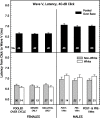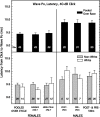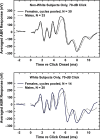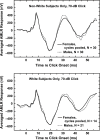Auditory evoked potentials: Differences by sex, race, and menstrual cycle and correlations with common psychoacoustical tasks
- PMID: 33979393
- PMCID: PMC8115856
- DOI: 10.1371/journal.pone.0251363
Auditory evoked potentials: Differences by sex, race, and menstrual cycle and correlations with common psychoacoustical tasks
Abstract
Auditory brainstem responses (ABRs) and auditory middle-latency responses (AMLRs) to a click stimulus were measured in about 100 subjects. Of interest were the sex differences in those auditory evoked potentials (AEPs), the correlations between the various AEP measures, and the correlations between the AEP measures and measures of otoacoustic emissions (OAEs) and behavioral performance also measured on the same subjects. Also of interest was how the menstrual cycle affected the various AEP measures. Most ABR measures and several AMLR measures exhibited sex differences, and many of the former were substantial. The sex differences tended to be larger for latency than for amplitude of the waves, and they tended to be larger for a weak click stimulus than for a strong click. The largest sex difference was for Wave-V latency (effect size ~1.2). When subjects were dichotomized into Non-Whites and Whites, the race differences in AEPs were small within sex. However, sex and race interacted so that the sex differences often were larger for the White subjects than for the Non-White subjects, particularly for the latency measures. Contrary to the literature, no AEP measures differed markedly across the menstrual cycle. Correlations between various AEP measures, and between AEP and OAE measures, were small and showed no consistent patterns across sex or race categories. Performance on seven common psychoacoustical tasks was only weakly correlated with individual AEP measures (just as was true for the OAEs also measured on these subjects). AMLR Wave Pa unexpectedly did not show the decrease in latency and increase in amplitude typically observed for AEPs when click level was varied from 40 to 70 dB nHL (normal Hearing Level). For the majority of the measures, the variability of the distribution of scores was greater for the males than for the females.
Conflict of interest statement
The authors have declared that no competing interests exist.
Figures





References
-
- Hall JW III. eHandbook of auditory evoked responses: Principles, procedures and protocols. New York: Kindle Direct Publishing; 2015. ASIN: B011J59898
Publication types
MeSH terms
Grants and funding
LinkOut - more resources
Full Text Sources
Other Literature Sources
Miscellaneous

